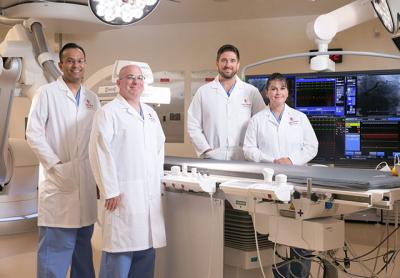Lifesaving Heart Care Now Closer at Stony Brook Southampton Hospital

Just over a month after the merger that rebranded the South Fork’s only hospital Stony Brook Southampton Hospital, the doors opened for one of the most critical new services offered there.
The cardiac catheterization laboratory, at Stony Brook Southampton’s Audrey and Martin Gruss Heart and Stroke Center — where patients with severely narrowed or blocked arteries of the heart are treated with stents to open passageways — was put to use for the first time on Tuesday. The procedures are considered lifesaving, some done on an emergency basis, others as elective treatments.
A blocked artery in a heart-attack patient should be opened within 90 minutes of contact with medical care, according to standards of care. Until Tuesday, the closest such lab had been at Stony Brook University Hospital, a 58-mile or one-hour ride from East Hampton Village. Patients in need of the diagnostic tools or the emergency lifesaving procedures available in a cath lab had to be either taken by ambulance or airlifted to Stony Brook, delaying that critical care.
“Faster access to the highest standard of cardiac care means more immediate, lifesaving diagnosis and treatment for residents of the East End of Long Island,” said Dr. Travis Bench, the director of the cardiac catheterization lab at Stony Brook Southampton.
Stony Brook University Hospital’s protocol for emergency catheterization has produced an average “door-to-perfusion” time of 56 minutes, almost 45 minutes below the New York State regulated treatment guidelines, according to Dr. Javed Butler, the chief of cardiology at Stony Brook University School of Medicine and co-director of the Stony Brook University Heart Institute. “This is the level of care we strive for at Stony Brook Southampton Hospital.”
The new state-of-the-art facility in Southampton, staffed by cardiac specialists from the Stony Brook University Heart Institute, is the only facility of its kind on the East End. Doctors perform a non-surgical procedure in which a catheter is inserted through the skin to reach affected areas. Peconic Bay Medical Center in Riverhead plans to open a cardiac catheterization laboratory this fall.
Depending on the patient’s situation, procedures at the Southampton lab can include a detailed assessment of the heart’s performance to locate blockages or narrowing of the arteries; angioplasty, a procedure that involves inserting a balloon-tipped catheter to clear blocked arteries; stenting, a procedure in which an expandable metal coil is placed in a narrowed artery to keep it open; intravascular ultrasound, which uses high-frequency sound waves to create images to help doctors determine the extent of disease, and Impella, a treatment for heart failure that implants a tiny device in the left ventricle of the heart to improve blood flow and stabilize the patient for transfer for further treatment.
It is an exciting advancement in health care on the eastern end of Long Island and will be a benefit to people from Montauk to Hampton Bays, according to Philip Cammann, a longtime paramedic on the South Fork and a member of the East End Ambulance Coalition, which supported the hospital’s application for a cardiac catheterization lab. The new facility cuts down on the amount of time a patient has to wait before getting an emergency procedure done. While airlifting patients to Stony Brook has proven beneficial, having the procedure available in Southampton could shave off 45 to 50 minutes — even more on a day like yesterday, when torrential downpours in the morning would have meant the helicopter was grounded. When talking about dying heart muscle, time is critical.
“We have the population,” Mr. Cammann said. “It not only gives the patient and the community better care and more prompt care, it also puts the resources of E.M.S. back in service a lot quicker. It’s a double benefit.” During a time when emergency call volume has increased — and membership in the mainly all-volunteer agencies has decreased — getting a patient to the hospital and freeing up the ambulance to answer additional calls has become even more important.
The Suffolk Regional Emergency Medical Services Council announced the opening of the P.C.I. Center — that stands for percutaneous coronary intervention — to E.M.S. personnel on Friday. “Stony Brook Southampton Hospital may now be considered the ‘closest appropriate hospital’ for patients with acute coronary syndromes, in accordance with regional hospital transport policies,” the statement said.
The New York State Department of Health approved the lab in March. The heart and stroke center, which was completed in 2015, was built with the future cardiac catheterization lab in mind. A single, 600-square-foot room is being utilized for the program. Start-up costs were estimated at nearly $1 million. The lab will be staffed around the clock, seven days a week.
Robert Chaloner, the chief administrative officer at Stony Brook Southampton, said the move “truly signals the beginning of a new era of health care for our East End communities.”
“The new cardiac program is the most dramatic example of exactly the sort of collaboration we hoped would happen when Southampton Hospital joined Stony Brook Medicine, as we bring the region’s top medical services closer to where people live,” he said.
